I don’t know how many times I’ve started, stopped, and deleted trying to write something up on my trip to the Fukushima Hard-To-Return-To Area, AKA the Futaba District of the Fukushima Prefecture. Unfortunately, thanks to COVID-19, I have plenty of time to write this up now. I want to give thanks at the outset to my friend Robyn, the Hollywood photographer who I went with to Chernobyl, who came on this trip too and can view her gorgeous work here, some of which I’ve used in this post. I also want to give high fives to Jen Miller for inspiring me to see if I could make this visit even happen when we went to see sumo and to Brian Wanamaker who’s translation skills allowed the serendipitous, sake-filled meeting with Kae to be an inspiration. And, lastly, thanks to everyone who purchased a “Coffee Wave” BBotE bottle for making sure we had the cash on hand to have ADVENTURES!
From the top, I’m not gonna discuss the ongoing work at Fukushima Daiichi. Plenty of ink and electrons already spent on TEPCO and JAEA doing what they can there. We can hope for a TV show that summarizes the events at the power plant as the Tōhoku quake and tsunami struck as well as HBO’s Chernobyl did. My quibbles with that show are minor at best. My favorite thing about it was people coming to me saying “Phil, I think they got something wrong on Chernobyl” and my grin of evil delight when I got to tell them that Craig Mazin lovingly captured period authentic Soviet bullshit and presented it faithfully. But I digress, because what is more interesting to me is the efforts to decontaminate, rehabilitate, and re-inhabit the abandoned area around the power plant. The example of the Chernobyl Exclusion Zone and the “settlers”, who are mostly pensioners left in the lurch by the Soviet collapse, gives one path.
That’s not what Japan did/is doing. But let me say this right now, because belaboring this is what caused me to abort so many previous versions of this post:
These towns aren’t coming back. Not because they’re doing a bad job at cleanup. On the contrary, they’re doing an amazing job and are WAY more thorough than the Soviet Liquidators ever were. That is my professional opinion. Unlike Pripyat, a young nuclear boomtown for high fliers, the rural communities around Fukushima Daiichi were already fading away. The quake and tsunami just accelerated the pace.
There. I said it. Now maybe I can explain why without tripping over myself.
This tale starts eight years ago, on March 11, when my career took a dramatic shift when some tectonic plates moved too. If you search for “UC Berkeley radiation specialist” this is very close to my and a former coworker’s job title. We both lost months of work responding to a fire hose of phone calls, emails, and even faxes as the entire Pacific Rim turned to us as because The Algorithm™ clearly indicated we were the experts on what to do in when a reactor accident happened. More often than not, we had to refer everyone to the public affairs office who promptly turned around and asked us what they should say. This is the price of being professional staff and not tenured faculty; we don’t have the freedom of expression that comes with tenure, we’re just employees. I would like to note that this doesn’t necessarily mean the tenured faculty knew anything about what they were commenting on, but they do have the freedom to spout off to their heart’s content to any microphone and camera that came near. I actually went back to read the post I made two days after the quake and was quite surprised to see how well I covered things.
For everyone that has now seen the Chernobyl miniseries on HBO and has that vision in their head for Fukushima Daiichi, you missed the big differences: there was no graphite fire and, holy crap, that was a hell of a quake and tsunami. For everyone now coming to grips with the idea of a double hit of pandemic and then economic collapse with COVID-19, try the triple disaster of one of the largest earthquakes ever recorded, a huge tsunami, and then slap a nuclear reactor accident on top of that. On a positive note, at least this triple disaster was relatively local in scope. The contamination around the Futaba District is due to the fuel rods leaking some fission products and a bunch of contaminated/activated sea water from the tsunami plus the cooling water of last resort pumping into the spent fuel pools without filtration (much less deionization) first. There were thousands of tons of graphite that lit on fire and exploded at Chernobyl, lofting a totally different set of radioactive materials across the world. Don’t get me wrong, we could detect Fukushima drifting on the breeze across the Pacific within 48hrs but the isotopic mix and quantity was very different than Chernobyl’s. And, as always, the drum I beat constantly for public education: there is a world of difference between “detectable” and “dangerous”.
We were met at the train station by Shuzo in a prefectural government van. He made sure that the ID we’d brought with us matched what I’d supplied to him a few months earlier because and, I quote, “It would be very embarrassing if it did not as I wrote the security procedures.” A little later as we drove past a cultural festival and Shuzo gave an embarrassed chuckle as he said he should probably drive a little bit faster in case some of his people working the fairgrounds saw the van. I asked him how many people worked for him in his office. He replied with some uncertainty “”Four…five hundred? Plus contractors, of course.” I slowly turned my head as realized I wasn’t talking to someone in a roughly similar position to me back in the states, but rather an agency head that reported directly to the governor… and he had volunteered himself as a driver and guide because this project is so important to him. Some recalibration of the honor that was being done for us happened in my head then and there.
Shuzo has a dream to get his hometown back. As a “hometown boy done good” he isn’t just any prefectural official, he had to order his own family out of their homes and off their farms. He evacuated the JAEA office during the emergency. What he wants more than anything is for the communities to come back after the quake/tsunami/nuclear accident triple disaster. And, yes, you should always look at this is in that order of severity; the reactors were the least of the three but it has the consequences everyone is afraid of. The people most afraid of the quake and tsunami are, well, dead. As part of the TEPCO/JAEA remediation plan, as the Japanese government made a commitment that Futaba would not be abandoned like the Chernobyl Exclusion Zone and had learned some lessons from that; all of the local towns and farms were offered a settlement to turn everything over for decontamination and/or demolition. Shuzo’s job is to make that happen. He is quite literally in charge of everything that is outside of the power plant decontamination project. The first place he wanted to take us was to his father’s farm.
I helpfully already did some work of sharing an introduction to my hosts in 2018 when I first started writing this up. From that post:
First off, let me introduce you to Shuzo Sasaki, Karin Taira and their project, Real Fukushima. Unlike the Chernobyl tours of varying quality done by various independent operators, this is a Fukushima Prefecture government project to show the work done for decontamination and rehabitation of the towns in the Fukushima Exclusion Zone. Karin runs the prefecturally sponsored B&B in Odaka called Lantern House which I highly recommend if you have the time to stay overnight (sadly, I did not). Shuzo is a prefectural government official who grew up in a town that is now in the exclusion zone and he’s become head of the redevelopment agency. When you are the boss, you’re allowed to give yourself any extra tasks you want; the one he has chosen for his extracurricular activities is showing people the work done to rebuild and reoccupy. Only foreigners at the moment because, and I quote, “I feel foreigners have less radiophobia than the Japanese.” While I didn’t laugh out loud at this, I did tell him that if this was actually the case that my day job would be much easier. As a local boy done good, Shuzo’s desire is to see the people in the towns he’s always known and loved come home. He would also like people all over the world to see their hometowns in his. That you might remember to give your loved ones a call now and then, maybe go home and visit. They miss you, you know. :)
Shuzo is the person that wrote the procedures for entry into the Fukushima Exclusion Zone. Shuzo is the person who is ultimately responsible for the decon, demolition and reconstruction of all the towns in the Exclusion Zone. This is personal to him.
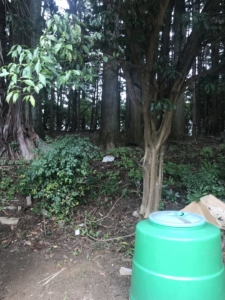
Among the people that had to be evacuated were Shuzo’s parents. Shuzo isn’t the eldest son, so his brother’s family ended up taking them in. And then when the evacuation area was expanded, all of them got evacuated again together. This was a bit too much stress on his mother and she passed away. For the next several years, his father lived with his brother’s family even after dad’s home and farm were decontaminated because they didn’t necessarily trust dad to live on his own. At 82, he’d literally never done laundry or really cooked a meal in his life so they needed to teach him some basic survival skills before they could let him go back home to live alone. His father’s farm is a good demonstration piece to show the success of decon allowing reoccupation, but also it’s limitation. The house, driveway, sheds, and yard had no detectable radiation above background, but you didn’t have to walk far into the trees at the edge of the property for the count rate to rise a bit. This is a reflection of the phased approach to decontamination: homes/cities, then farms, then undeveloped land. Dad wasn’t home, but I am proud to say his dad left signs that he’s like every other farmer I’ve ever met: the there was a can of Asahi beer stuck in the forks of his tractor by the shed.
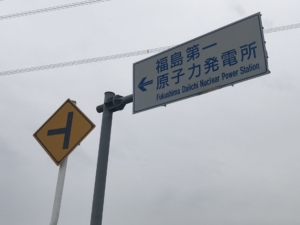
As we approached the turn off for the power plant, Shuzo asked if any of us had seen the Fukushima/Robot Hotel episode of Dark Tourist. He was rather pleased to hear that none of us had and let us know that know that, if/when we did watch that episode, it was filmed without permission. All they did was drive up and down Route 6 for hours and hours, the highway that runs through the exclusion zone, which is open to public travel but no stopping is permitted. You will note in that episode they stop a couple of times and then are promptly chased back to their vehicle by decon workers and police. To be very clear, this is not like the Chernobyl Exclusion Zone. No independent operators are doing tours around here and the local government has enough control to make that stick. They don’t want the disaster tourism; they want you to see the work they’re doing to recover, not wallow in the ruins and destruction.
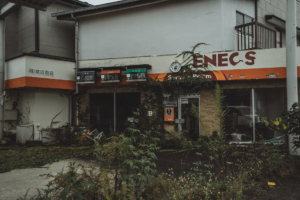
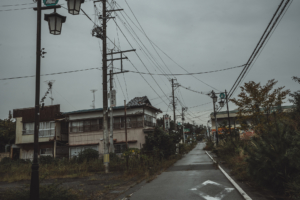
To hammer that point home in Tomioka, when we stopped to stretch our legs and let Robyn get some excellent pictures, Shuzo was struggling to find a word in English as we walked around the old downtown where he wanted us to be careful. That while all this was slated for demolition, these were the former homes and business of friends and neighbors. That he was their custodian until the town could be rebuilt and they all could come back. I let him know that the word he was looking for was “respect”, that he wanted us to be respectful of the loss that happened here. That he wanted us to be respectful in a way the Dark Tourist folks weren’t.
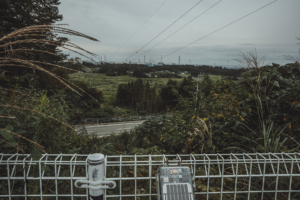
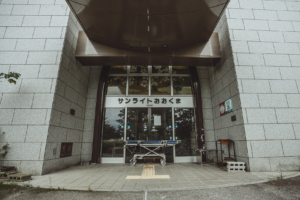
Shuzo wanted to share an evacuation success with us for the Sunlight Okuma senior center, which also had an overlook view to the power plant from the edge of their parking lot. When the evacuation went through, they were able to get all of their residents into transport and out of there. The lobby of the place was filled with wheelchairs, abandoned there after the residents were whisked away to safety, for given values of uncertain roads and bridges on the evacuation route at the time. But they got them all out, though some of them needed to be taken to the hospital as they were somewhat fragile.
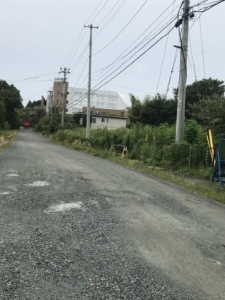
Ah, yes, the hospital that used to here. That was our last stop on the trip with the deepest “Oh” of the hard choices in crisis. This is where an bad situation gets fucking ugly as damaged logistics really reveal themselves. In the wake of the earthquake and tsunami, roads are cracked or washed out, train tracks are warped, and bridges over ravines and rivers are gone or structurally suspect. Getting from A to B in this comparatively rural part of Japan is fun at the best of times and the only thing you have going for you is that you aren’t in the mountains. Well, other than that whole tsunami washing up the river mouths and across a nice flat flood plain. This means your transportation network in very limited/damaged and you only have what resources are immediately available to you in this local network or by helicopter, for at least the next 24 hours but probably closer to 96. Now, with all that said, if you think evacuating an old folks home is hard, try ICU patients. How many ambulances are still available in this network? How many of them are currently headed toward the hospital with new patients? How long will the generators at the hospital keep running and is it long enough to get them more fuel? Oops, the reactor is leaking, every one has to go NOW.
The idea of Just In Time inventory management is absolutely toxic to the idea of emergency response. The pursuit of “efficiency” in a for-profit concern is an effort to reduce “waste” in the system to maximize profits. Doing the same in a non-profit setting cannot maximize profits, and the elimination of “waste” often confuses surpluses for contingency and public welfare as corruption & incompetence. The assumption that you only need one specialized response team for a given problem works on paper fine and “saves money”. But if you can’t get what you need to the disaster area that by definition is in the middle of a crisis this is a liability. You have deprived the local crisis area of the support that should tide them over until you can muster external resources. As Lenin said, every society is three meals from chaos. We have seen this in Katrina, Maria, Haiti…and Fukushima is an object lesson.
At least most of the old folks were ambulatory or could be moved by wheelchair. In the hospital, you had people who had to be moved by stretcher. An ambulance can only move one stretcher bound patient at a time, so they put what school buses they could lay hands on into service for evacuation, lining the aisle of the bus with patients, but that’s still only 3-4 in the aisle per bus plus whoever you can put in the seats. Then there were those on life support who couldn’t be moved at all. Please take a moment to imagine you are a doctor who has been ordered to evacuate, because a nuclear accident is in progress and there are other disaster victims elsewhere too, but it is also quite clear if you leave these patients that they will die. That when the power fails and there’s no way to keep the generators going, even if you stay here with them, they will die. And the generators will die because the best hope, reconnecting the national power grid, is a non-starter because the best and least devastated option is the grid on west side of Honshu. Unfortunately, due to post-WWII reconstruction issues, the eastern and western sides of the island are running on different frequencies, 50 & 60Hz, and you can’t just plug one side into the other. And so, knowing what would happen, the medical staff evacuated, leaving 128 people behind in the hospital. They were assured that getting back to this hospital to evacuate those patients would be a high priority for the Japanese Self-Defense Forces who been activated to respond.
When they got there, most of the patients were comatose and 14 died shortly thereafter. When telling the story of responding to the aftermath of the quake, this is the part that makes Shuzo most upset. That they weren’t prepared enough such that this choice had to even be made. Having lived through the Loma Prieta quake in Santa Cruz County and having the earth sciences background to know how much worse this was, I have a hard time imagining how you can be prepared enough. But this choice haunts him, the first responders, and the former staff of that hospital still. It is a source of shame, even in one of the worst natural disasters to strike Japan. I sincerely wish we could borrow some of that shame for America dealing with COVID-19 here in 2020.
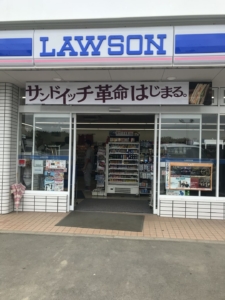
Let’s step this back a few because I want to discuss some of the problems Shuzo is up against now. Before heading to his dad’s place, we stopped at the Lawson Market in Namie for the final bathroom stop for the rest of the day until we got back to the train station. If you aren’t familiar with the central importance of Lawson Market in Japan, they are the convenience store. 7-11 exists too, in a quantity you would never imagine in America, but they pale in comparison to Lawson and their most perfect egg salad sandwich. Unlike the Lawsons and 7-11s in Tokyo, which are 24/7/365 affairs, this one has limited hours since the population it serves is limited, mainly the workers at Fukushima Daiichi and the decon workers in the Hard-To-Return-To Area. After just two days in Tokyo, the idea of a Lawson that wasn’t eternally open, not to mention not having one in practically every block, just didn’t compute for me. The fact that it’s the only Lawson within an hour drive in any direction is another part of the difficulty in Shuzo’s mission to reclaim, rebuild and reoccupy.
The problem is that while people may return to these towns once they are rebuilt, they lack the critical mass to actually justify maintaining services. Repeat this Lawson’s problem of hours and limited population with health services. There was a large hospital here, as tragically mentioned previously, but there’s barely enough people to justify a clinic out in the towns now. Which means for the fairly elderly population that has returned, the trip to visit their doctor is at least a hour and change drive away away. And they better have a car and be able to drive because there’s no train service here yet (NB: as of 2020, train service has been restored to Namie). It’s planned, but it starts a chicken and the egg problem of “Will people come back if the services aren’t here?” vs. “Is it worth building services if there’s no one here to use them?”
The demographic shift to a more elderly population was already killing the small agricultural towns. Without the necessary population, there are modes of farming that just don’t work anymore. For traditional rice farming, farms/families would supply their extra children or workers to do maintenance on the irrigation ponds that would then flood the paddies at the right time of year. If you don’t maintain them, very soon it silts up, gets overgrown, and then you have no water for rice farming. And without continual maintenance of the irrigation to remain viable, many had shifted to more profitable crops, like ornamental flowers. But without enough local people to work the farms even in their new incarnation, most of the workers that had been there before the quake were Vietnamese. Imported produce was cheaper anyway so the local farms weren’t doing that well in the first place. And if you can’t fight the radiophobia, you won’t even get those workers. However, here is a tarnished silver lining.
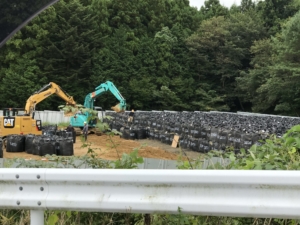
In America, we don’t do a lot of waste incineration anymore in the wake of very dirty burning of uncontrolled wastestreams and the subsequent downwind cancer clusters. Japan doesn’t really have the room to have all the landfills that we do, which means that rather than segregating trash into “garbage, compost, recycle” you get “recycle, combustible, non-combustible”. This principle applies to radioactive waste as well; you can’t make the radioactive component go away, but you can change the physical/chemical form you have to deal with. For low level wastes that will decay away relatively quickly, say less than 300 years for 10 half lives to pass, the preference is to reduce and concentrate so that it takes up as little space as possible while we wait for it all to die away. Part of the remediation project here is collecting contaminated topsoil and plants for incineration, AKA bulk reduction. The ashes are then consolidated into reinforced supersacks for transport and burial. Every one of those bags is tagged and recoverable, just like the Nevada Test Site. Radiologically and chemically, we know what’s in it, when it will cool down, and when it isn’t “waste” anymore. The burial option isn’t ideal as it takes that land out of use for decades to come and Japan doesn’t have a lot of spare land kicking around. But as I mentioned earlier, those old irrigation ponds all over the place that weren’t being used. There are ready made barrows, good to go for waste storage.
To roll this story even further back, the night before we went Fukushima, we had a wonderful dinner and an hell of a lot of sake at a joint near Meguro station (looking at the photo on the front page, we were seated at that first table on the right). We met a pair of ladies from the small town of Yamanashi, small being relative at ~40k residents, who had recently moved to Tokyo to get jobs which were lacking back at home. They were interested in why we were visiting Japan and we told her about our trip the next day. Between all the sake, Kae made the observation that “Most in people in Japan don’t feel a connection to or think about Fukushima much. Not many people call that part of Japan their hometown anymore.” That has tax consequences. I don’t want to go into it here, but I do recommend reading this essay on the Japan’s Hometown Tax.
Kae had a point, so I decided to look up the census info. Not many people were calling the towns of the Fukushima coast their hometown either (Namie, Tomioka, Okuma, Futaba, Hirono, Katsurao, Kawauchi, Naraha). Over a 20 year window, the population of the prefecture as a whole has dropped ~200k. The obliteration of the Futaba District only accounts for ~70k of that. And Fukushima City’s whopping 2k of growth doesn’t really explain that loss in terms of internal migration in the prefecture. Tokyo, however, has grown considerably. The economic machine of Tokyo demands fresh bodies and dang if it doesn’t suck them in from the rest of the country, much like it did Kae. In the United States, if you were a kid who grew up in a tourist town, and you had the realization “Seriously, waxing skis and serving assholes on vacation is all I can do around here for a living?” then it makes a lot of sense.
But I don’t want to leave you in despair for Shuzo and Japan.
And after 4000 words, you could probably use a pick me up. Bravo for making it this far!
I was, and remain, disappointed in myself for thinking the Tōhoku Line wouldn’t be rebuilt because America hasn’t finished the Gulf Coast Amtrak line since Hurricane Katrina. From my pre-trip post, except it’s been 15 years now:
I will say that in planning this I ran face first into some Very American Assumptions. As a train nerd, I am excited about the prospect of riding the shinkansen, even if it isn’t this one, but then I immediately said to myself “Oh wait, it might be hard getting out there with the amount of damage the quake and tsunami did. The shinkansen might not be up and running to Sendai yet.” After all, it’s been over a decade since Hurricanes Katrina & Ike and we haven’t gotten the Gulf Coast Amtrak routes repaired yet, which are comparatively primitive trains, and this was a much worse disaster. So, when I looked it up and saw that it was repaired and running, I was impressed. Then I got curious as to how long it took Japan to restore shinkansen service to the hardest hit area.
ANSWER: 43 days
It has been 13 goddamn years since Katrina and we can’t get Amtrak running, much less a bullet train. Amtrak’s trains are slower than what used to run on our rails 60 years ago. Not gonna lie, I was shook. As someone who complains regularly about terrible infrastructure and disaster response, I didn’t realize how acclimated to it I had become. I am disappointed in myself and, by extension, America because of this.
There’s a resettlement town for folks that returned after the quake built near the Hard-To-Return-To Area on the other side of Route 6. Apparently, the kids are the ones who demanded to go back because they missed their friends but they also wanted to consolidate. The elderly, much like at Chernobyl, wanted to go back to their old homes or at least something close to it. There’s a single school that in 2018 had a total of eight students, K-12, BUT THEY ARE THERE! And if you’ve got kids, your community has a future.
On the marketing side of things, they’re doing their damnedest to make sure that the radiophobia that lead to the hibakusha does not happen again for its residents or produce. Additionally, this area is a breadbasket of Japan full of amazing fruits, vegetables, livestock…it’s a region Japan can’t abandon for long. A “Fukushima Made” campaign to let people know they’re supporting the farmers and fishing boats to get them back on their feet is starting to get some traction. Not gonna call it a success where people pay a premium for Fukushima apples yet, but give it time.
Which is to say, if anyone is gonna pull off the biggest decon project since Chernobyl, my money is on Japan. I’m just not sure who is going to move back.